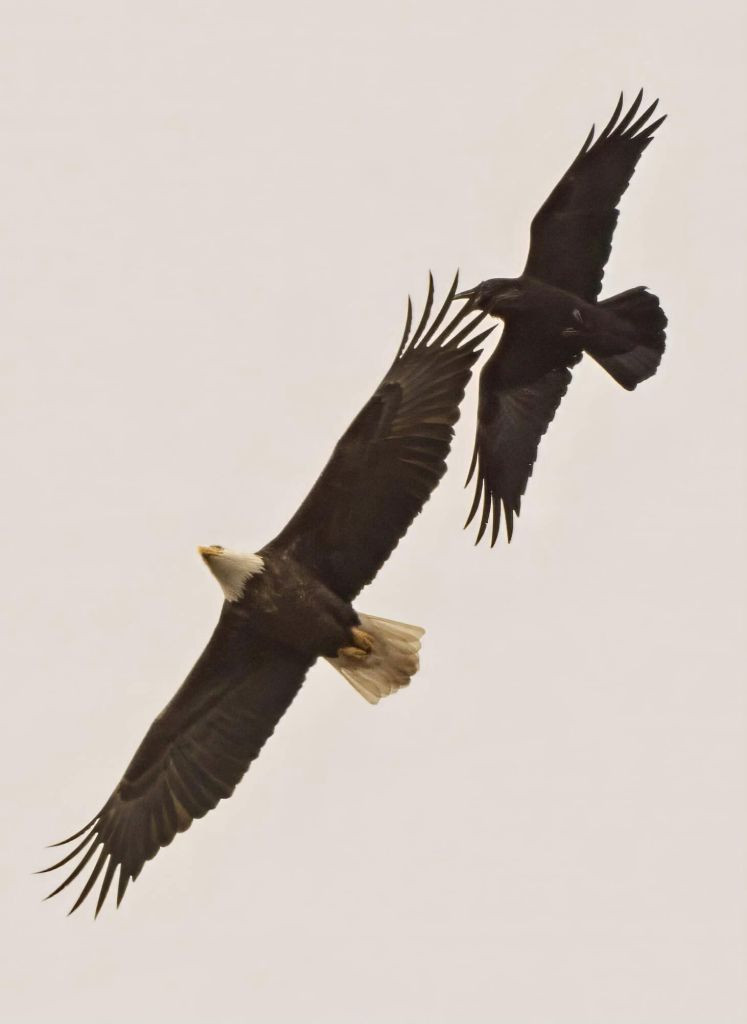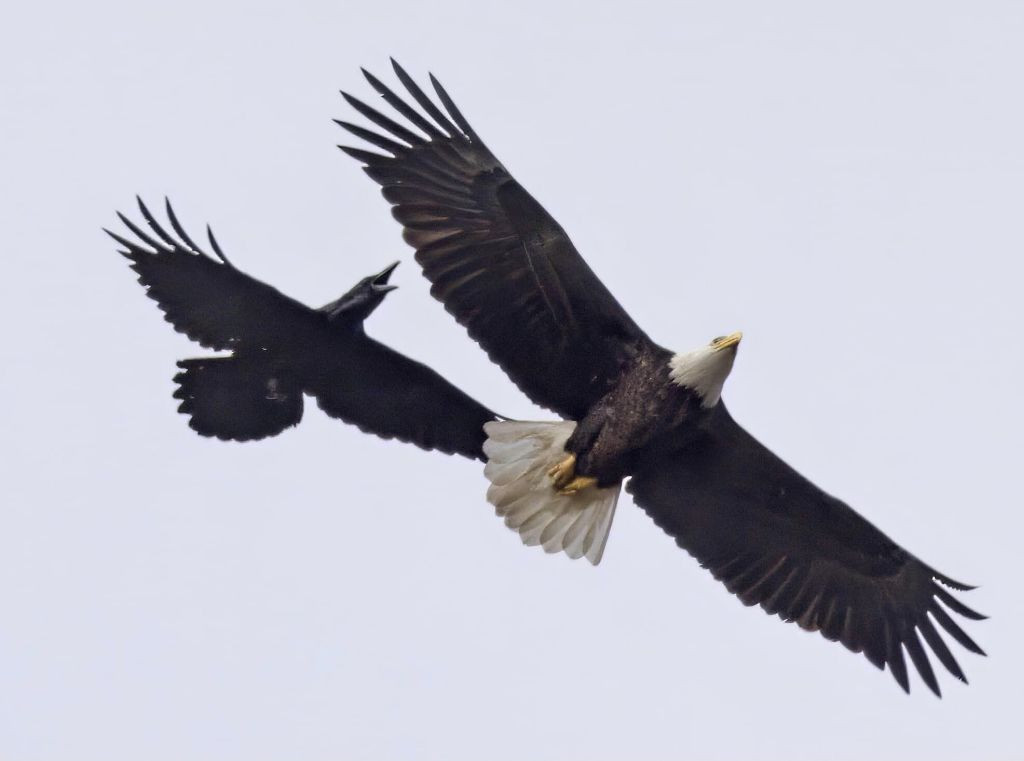The skies above Hays Woods in Pittsburgh recently witnessed a drama: a bold raven harassing “V,” the new male bald eagle. Photographer Jim McCollum captured the aerial chase, sharing photos that sparked a fascinating question about bird flight and altitude. This incident prompted a discussion in the 40 Acres a.k.a. Hays Woods Enthusiasts Facebook group, where a member recalled a tale of crows tiring out eagles by forcing them to fly to extreme heights. But is there any truth to this myth, and just how high can an eagle actually fly?
 Raven aggressively chasing a bald eagle in flight at Hays Woods, Pittsburgh, showcasing aerial harassment behavior.
Raven aggressively chasing a bald eagle in flight at Hays Woods, Pittsburgh, showcasing aerial harassment behavior.
Debunking the Crow-Oxygen Myth: Why Crows Don’t Pass Out Mid-Air
The story goes that crows will perch on eagles’ backs and peck at them, forcing the eagles to ascend to such heights that the crows, lacking oxygen, will faint and fall off. While captivating, this narrative doesn’t quite align with avian biology. Birds, in general, are remarkably well-adapted to high altitudes, far exceeding human capabilities. Some species can even thrive and fly at altitudes comparable to jet planes, soaring over the Himalayas where humans would struggle to breathe without oxygen. Migratory birds in the Caribbean, for example, are commonly observed at 10,000 feet, with some reaching twice or even half that altitude. Long-distance migrants often begin their journeys around 5,000 feet and progressively climb to an astonishing 20,000 feet.
Therefore, the idea that a crow would succumb to oxygen deprivation at an altitude an eagle can reach is highly unlikely. The reason a crow might stop harassing an eagle mid-flight is far simpler: it’s either because the eagle is no longer perceived as a threat, or the crow simply tires of the chase.
 Mid-air confrontation between a raven and a bald eagle, highlighting the smaller raven's attempt to bother the larger bird.
Mid-air confrontation between a raven and a bald eagle, highlighting the smaller raven's attempt to bother the larger bird.
The Amazing Altitude Capabilities of Eagles
So, if oxygen deprivation isn’t the limiting factor in these aerial disputes, what are the actual altitude limits for eagles and their corvid counterparts? While precise flight ceilings can vary depending on species, individual health, and environmental conditions, eagles are undoubtedly high-flying champions. Bald eagles, like “V” in Hays Woods, are known to soar to impressive heights. While specific maximum altitudes for bald eagles are not widely documented, other eagle species offer clues. For instance, Golden Eagles have been recorded flying at altitudes up to 15,000 feet (around 4,600 meters). Rüppell’s vultures, often considered the highest-flying birds of prey, have been observed at an incredible 37,000 feet (approximately 11,300 meters).
Eagles possess several physiological adaptations that enable them to thrive at high altitudes. Their respiratory systems are incredibly efficient at extracting oxygen from thin air, and their blood is optimized for oxygen transport. These adaptations allow them to fly and hunt effectively in environments where oxygen levels are significantly lower than at sea level.
 Bald eagle soaring high above Hays Woods as a raven pesters it from behind, illustrating the dynamic interactions in bird behavior.
Bald eagle soaring high above Hays Woods as a raven pesters it from behind, illustrating the dynamic interactions in bird behavior.
Comparing Eagle and Raven Flight Altitudes
While ravens are also adept fliers, and capable of impressive aerial maneuvers as seen in their harassment of the Hays Woods eagle, they generally do not reach the same altitudes as eagles. Ravens are comfortable at lower to mid-altitudes, typically up to around 8,000-10,000 feet. This is more than sufficient for most environments and interactions with other birds, but it likely falls short of the maximum altitudes eagles can achieve.
In conclusion, while the image of a crow forcing an eagle to faint from lack of oxygen is a compelling story, it’s not grounded in scientific fact. Eagles are masters of the sky, capable of soaring to remarkable altitudes thanks to their evolutionary adaptations. The raven’s harassment of the Hays Woods eagle is more likely a display of territorial behavior or playful aggression, ending not due to oxygen deprivation, but simply because the smaller bird decides to give up the chase. To delve deeper into the world of high-flying birds, explore resources like “High-altitude champions: birds that live and migrate at altitude” and “As High As A Jet.”

